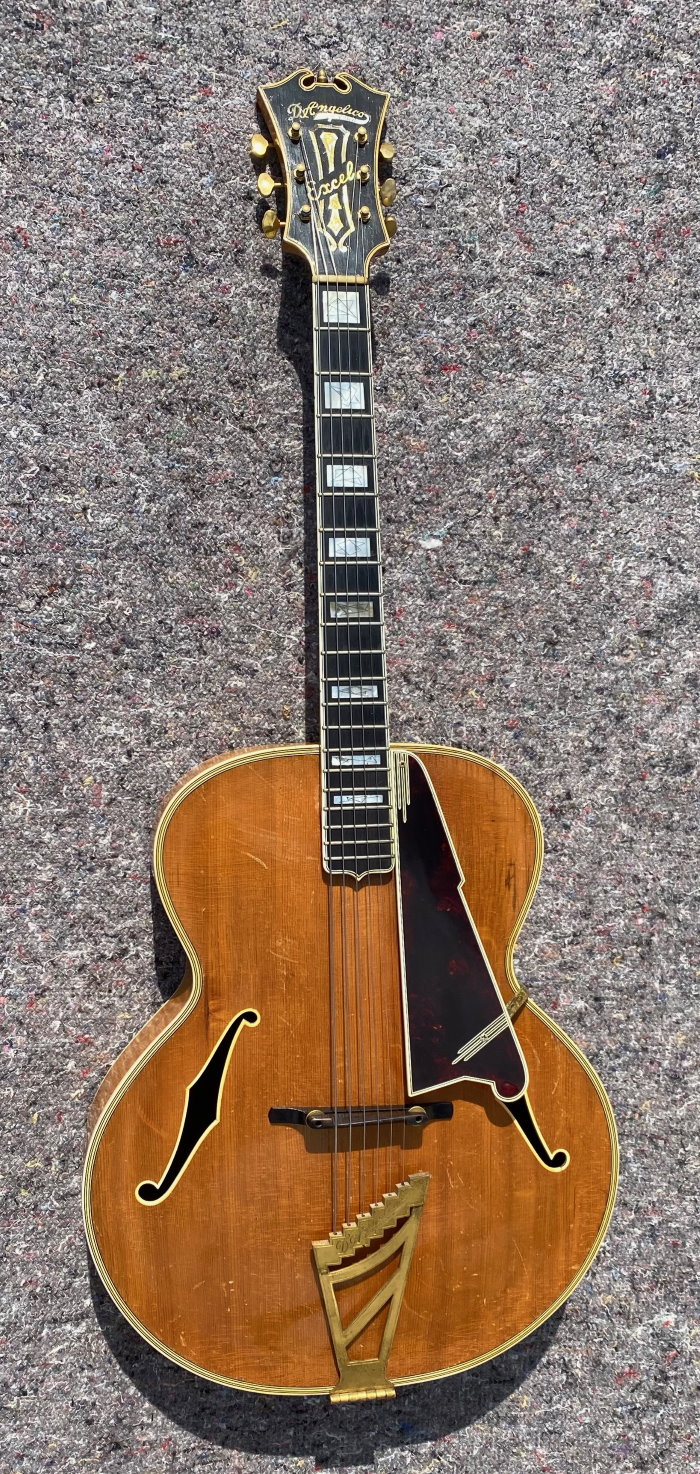

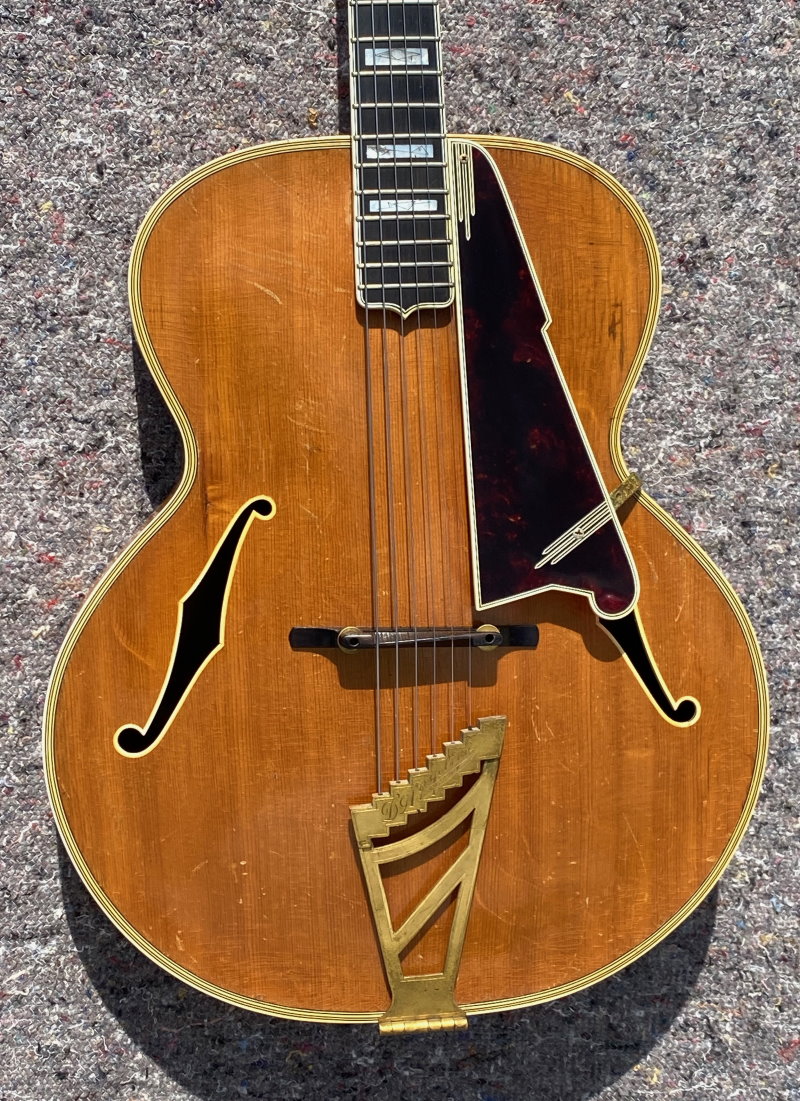

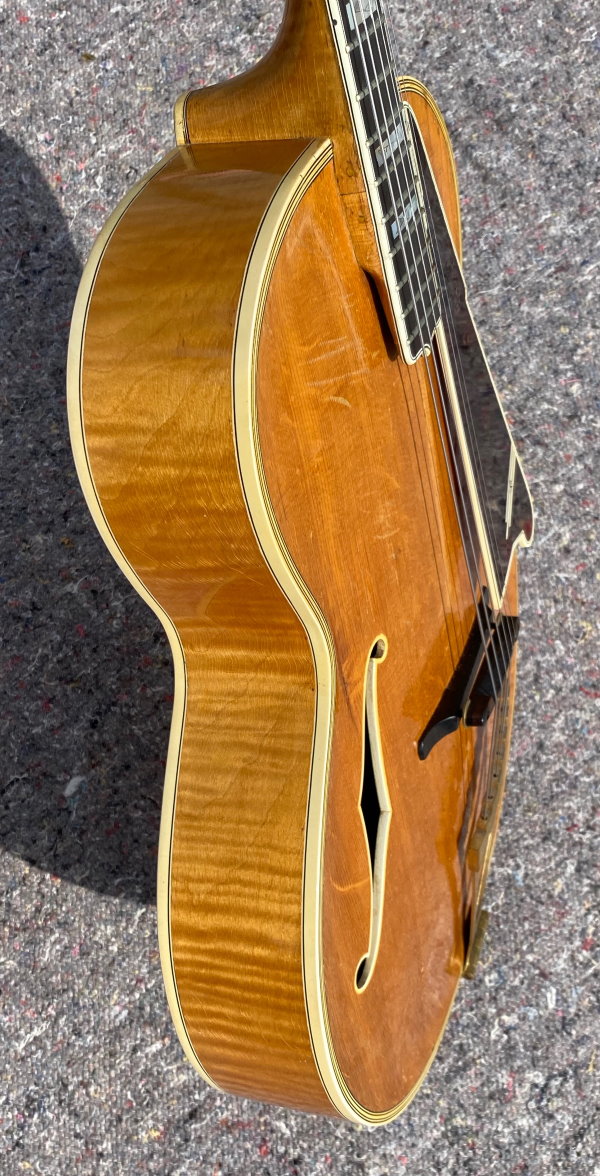
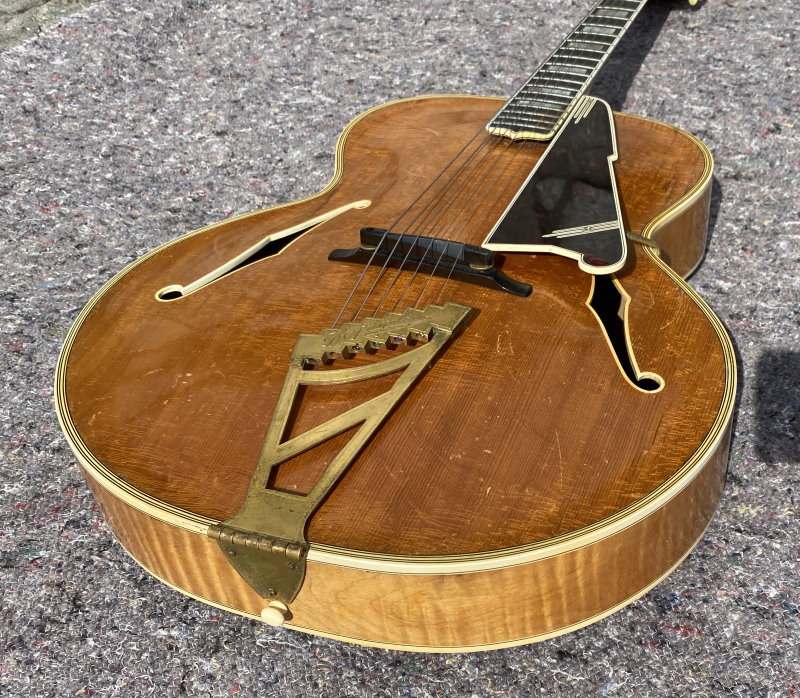
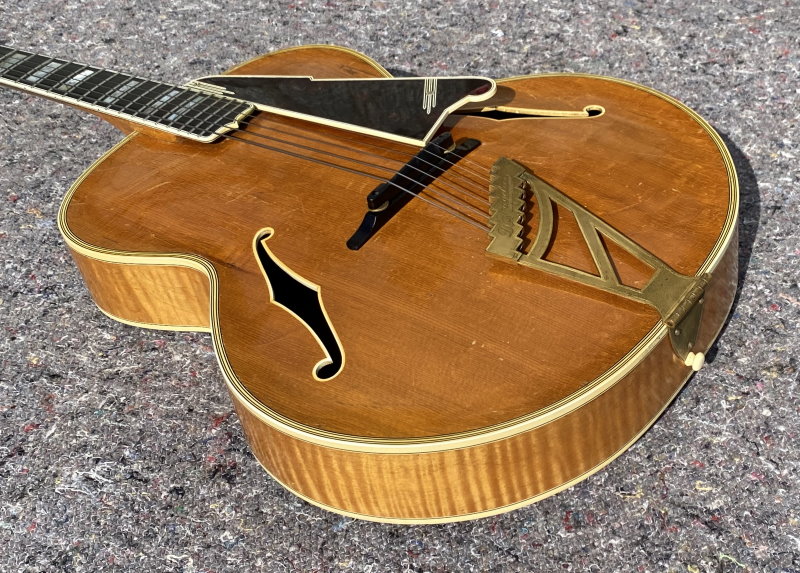
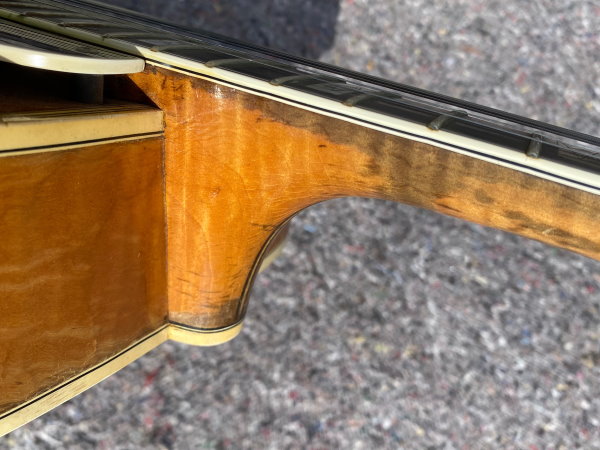
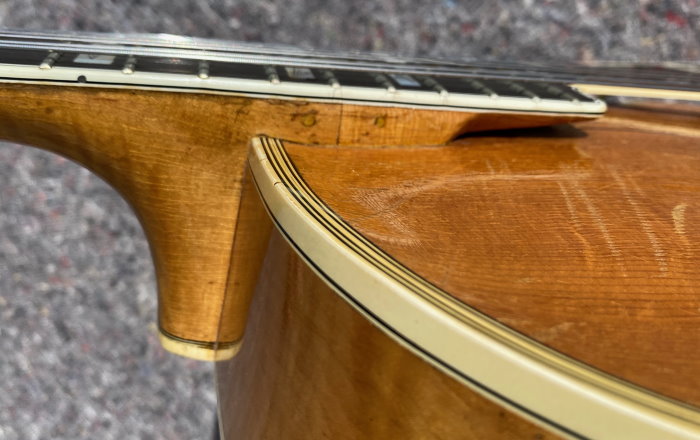
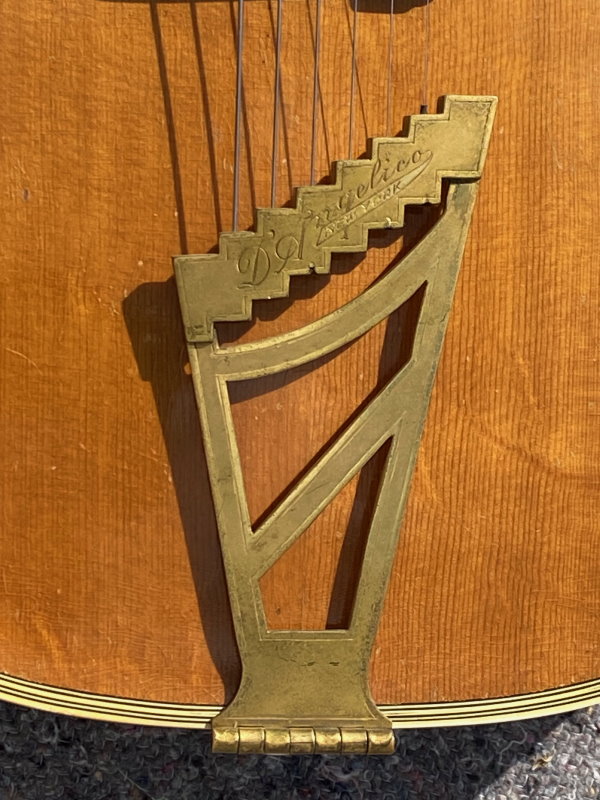

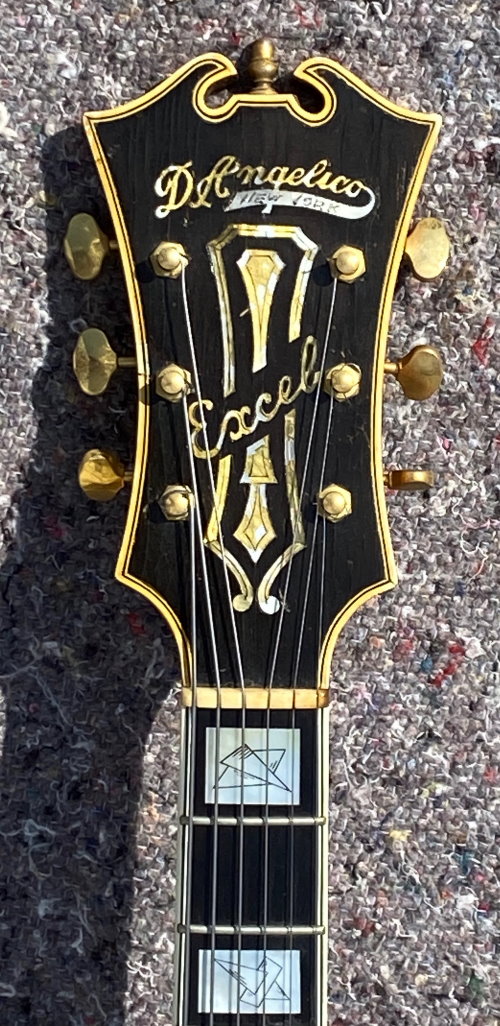

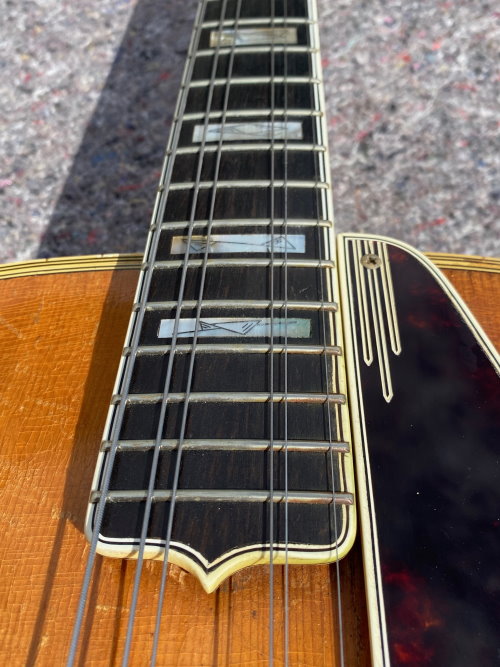
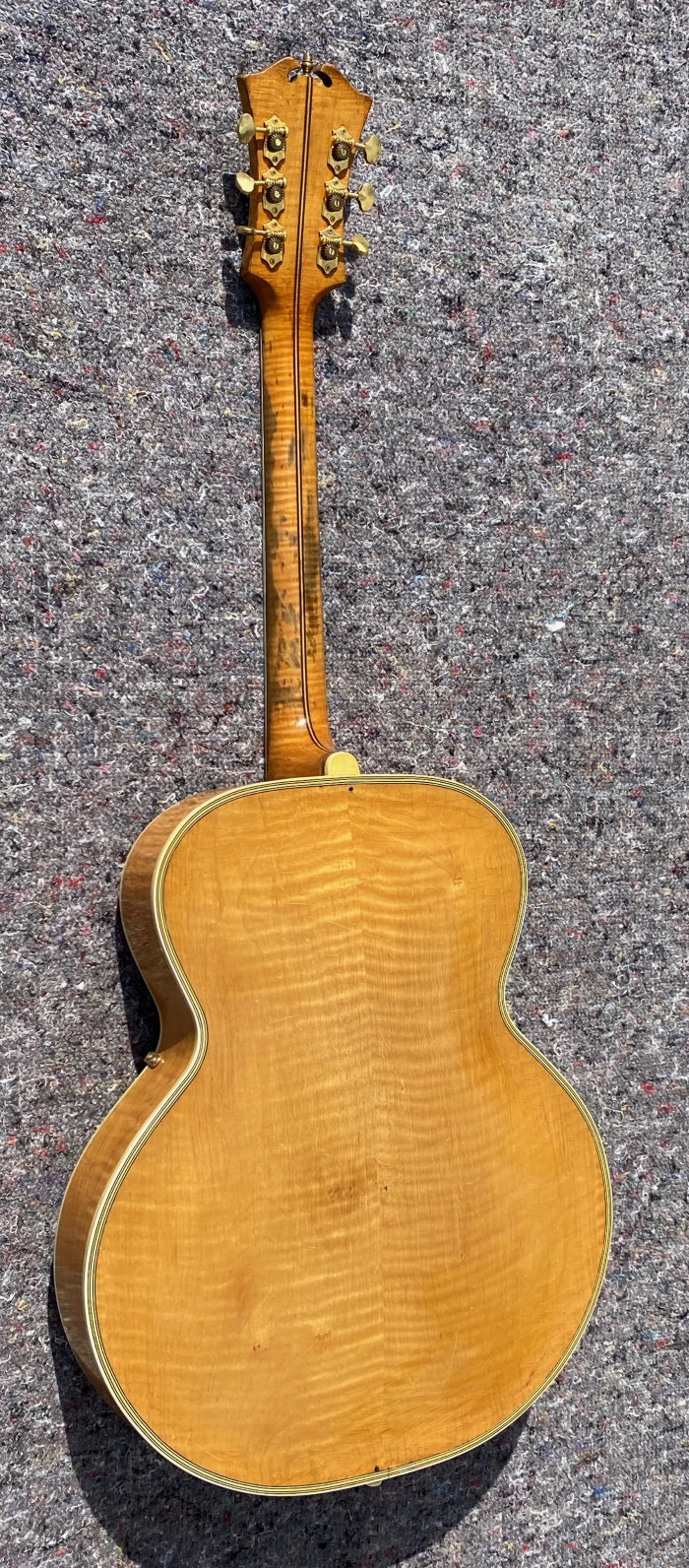
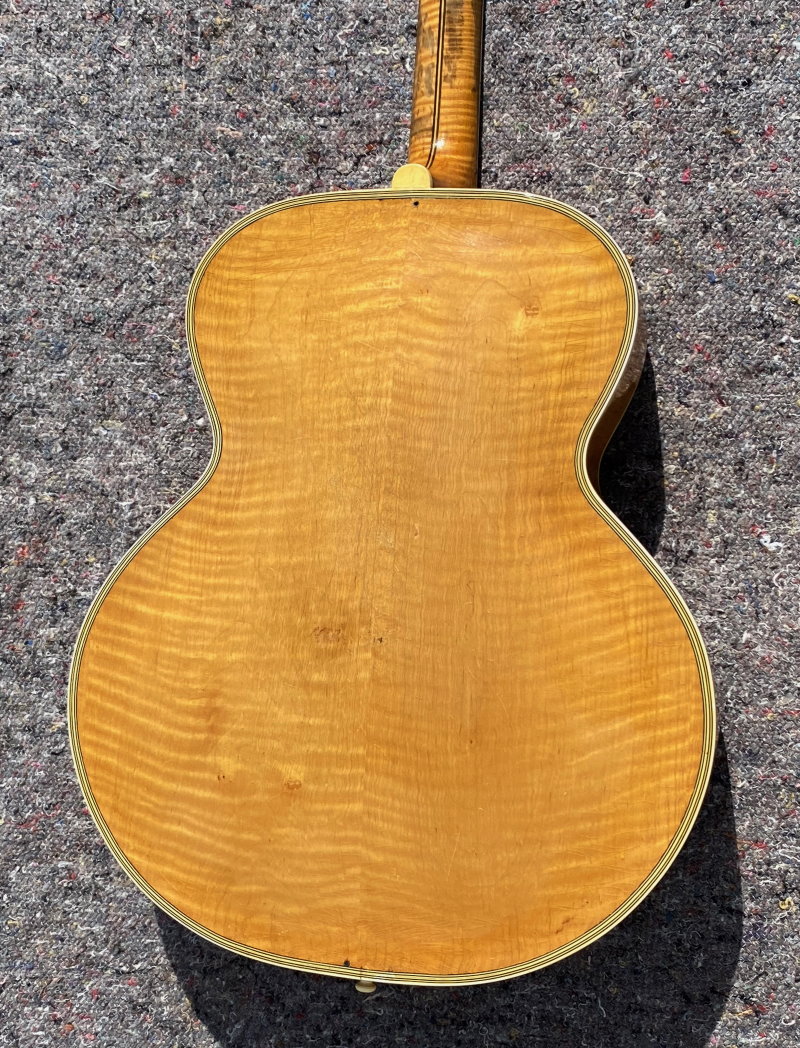
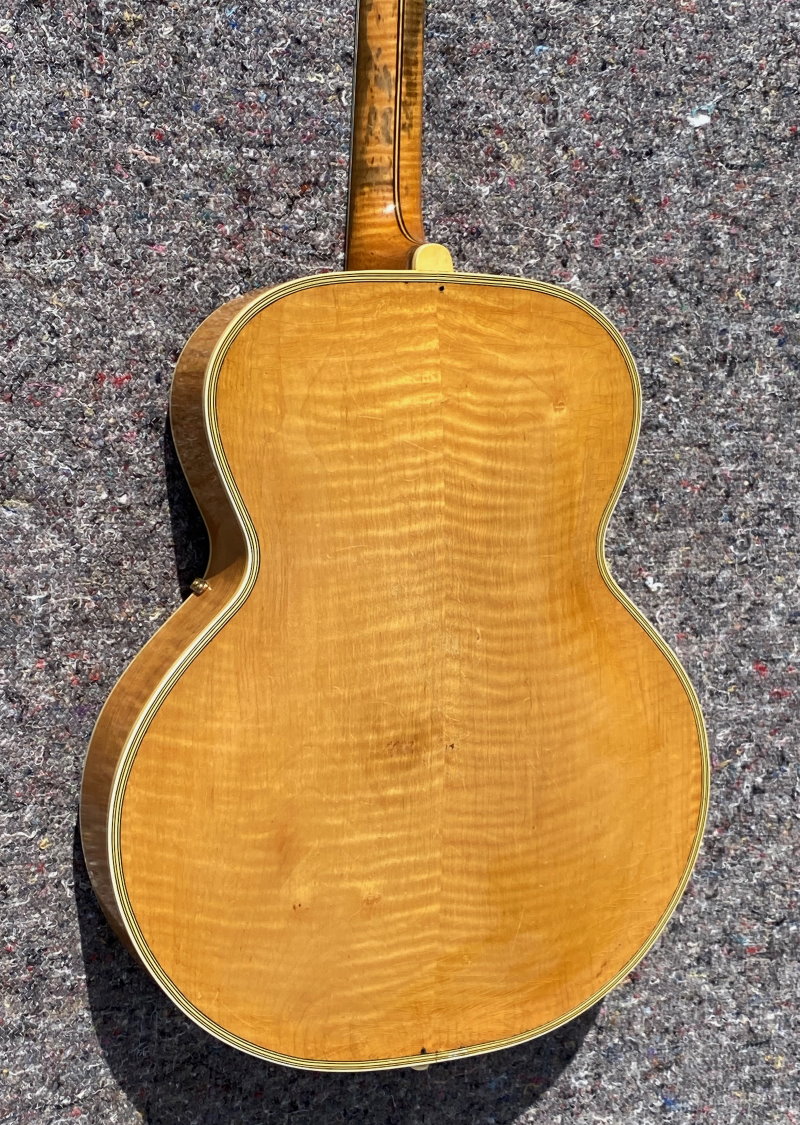
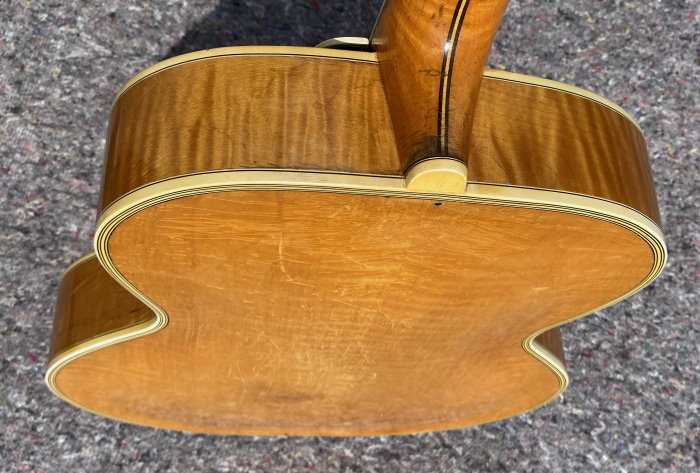
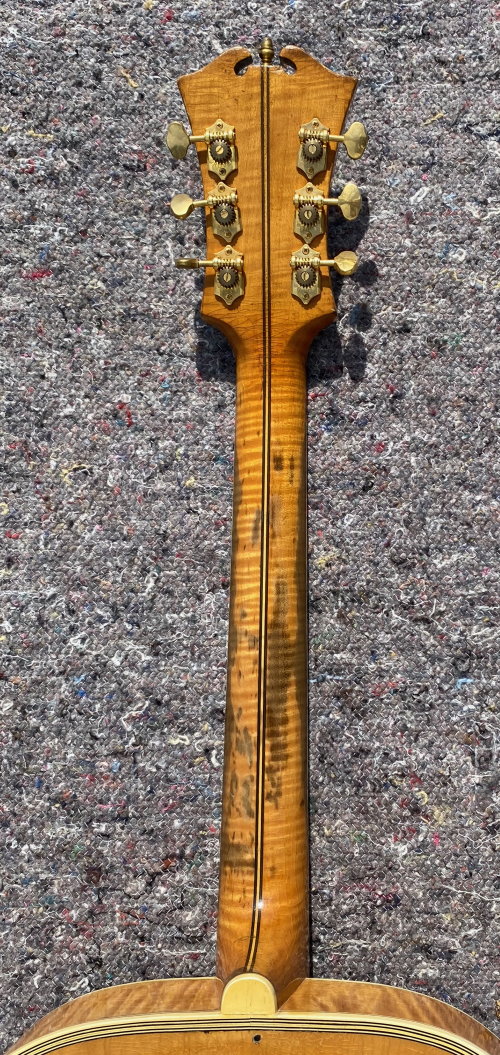

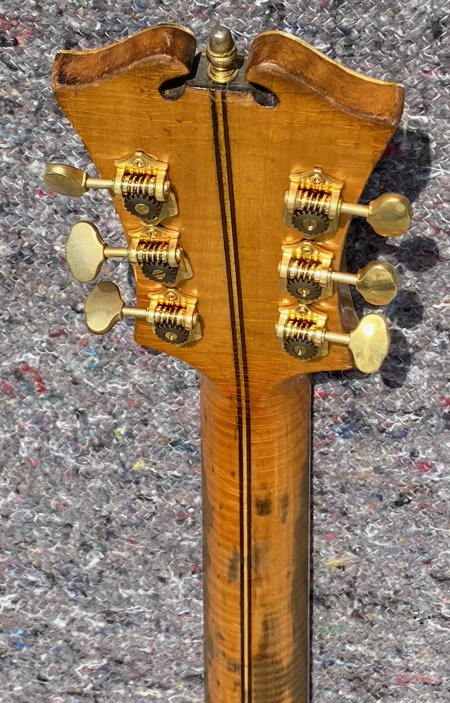
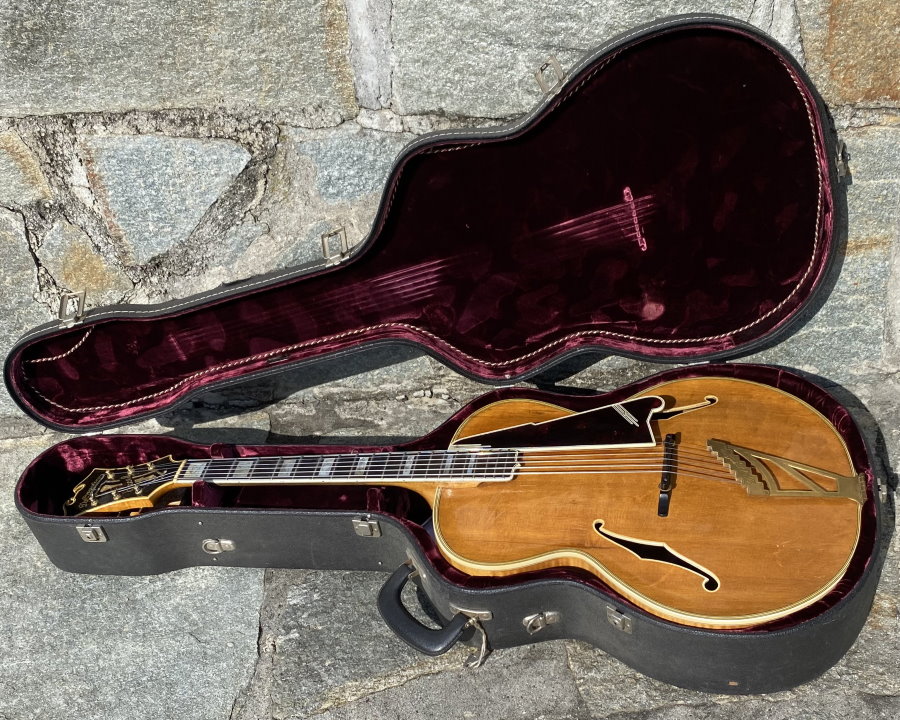
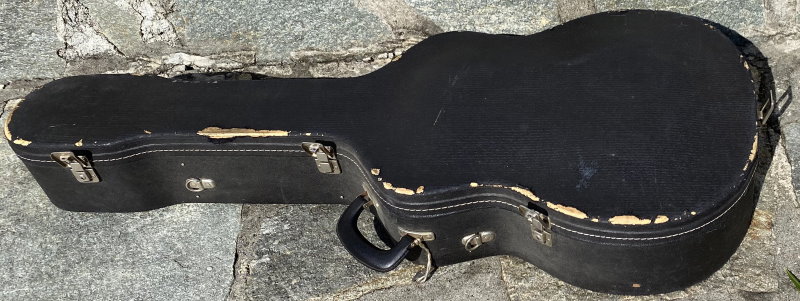
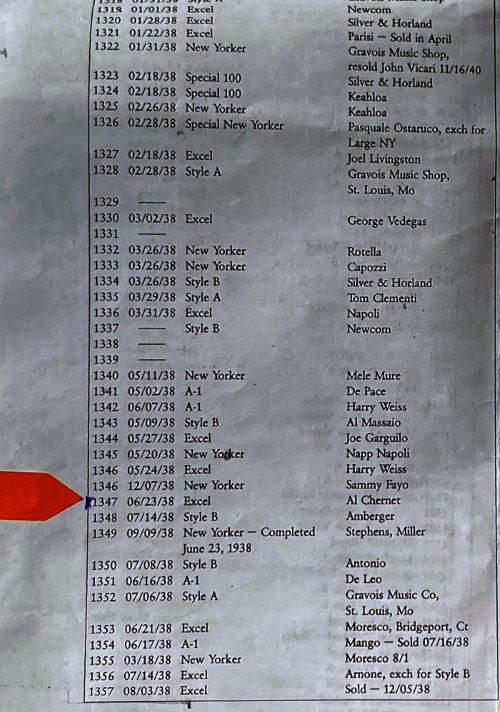
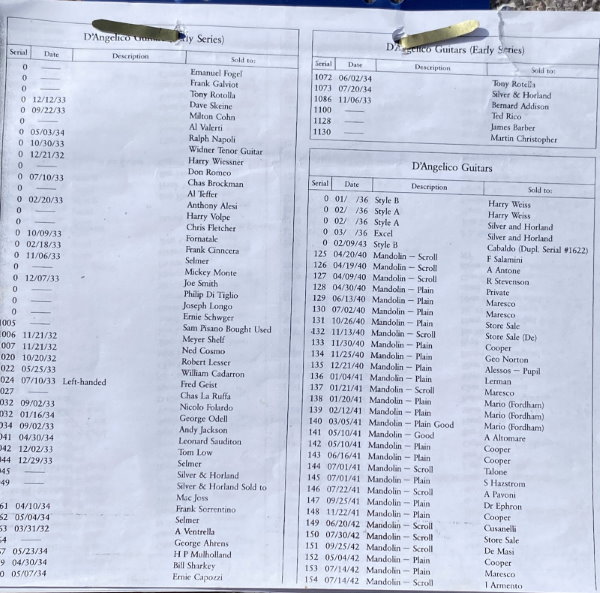
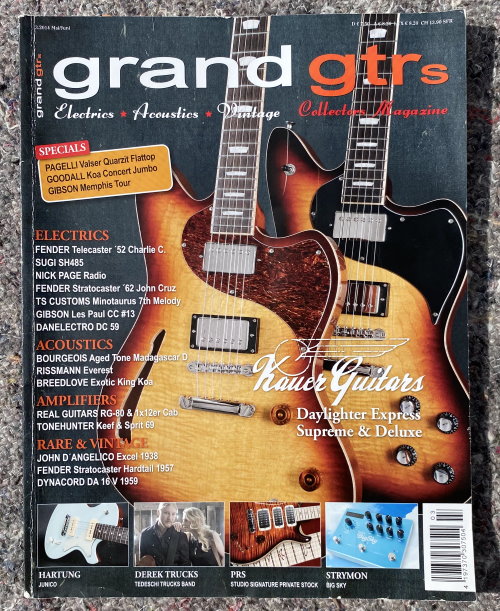
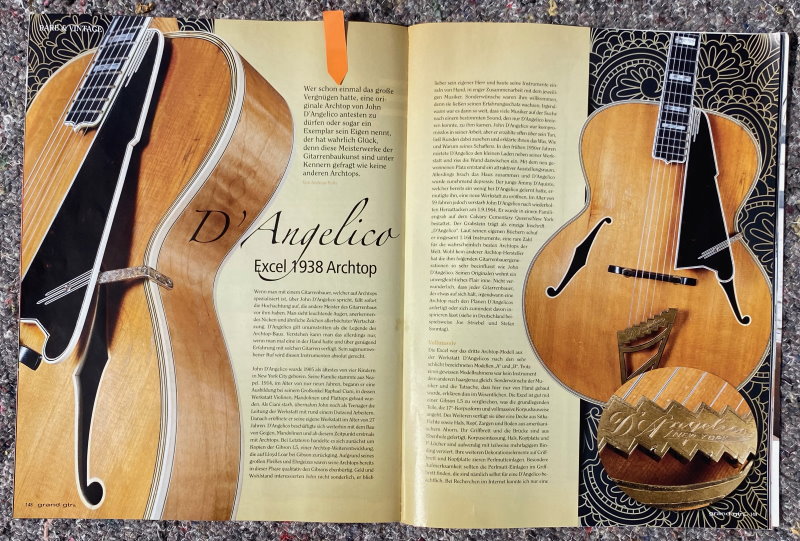
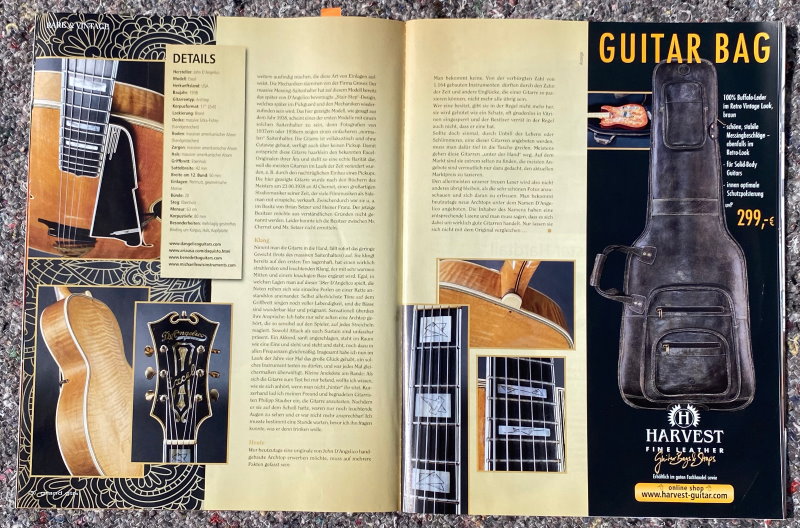


D'Angelico Excel of Mario Bagnoni
1938 D'ANGELICO EXCEL 17'' Archtop Guitar Code AC07
100% Original except correct tuners. No breakages or repairs, ding&dong, little war normal use of an instrument over 86 years old!!!
Original D'Angelico - Excel 17" Archtop Guitar from 1938 - in excellent condition! Anyone who has earned the great pleasure of owning an original John D'Angelico archtop is truly lucky, because these masterpieces of guitar making are sought after by connoisseurs like no other archtop. When you talk about Giovanni D’Angelico with a luthier who specializes in archtops, you immediately notice the respect that other master luthiers have for him. You see shining eyes, appreciative nods and similar signs of the highest appreciation. D’Angelico is indisputably considered the legend of archtop building. However, you can only understand this if you have held one in your hands and have enough experience with such guitars. These instruments absolutely do justice to their legendary reputation. The Excel has a Sitka spruce top and an American maple neck, headstock, sides and back. The fingerboard and bridge are made of ebony. The body frame, neck, headstock and F-holes are richly decorated with a partially multi-layered binding. The other decorative elements on the fingerboard and headstock are decorated with mother-of-pearl inlays. Special attention should be paid to the mother-of-pearl inlays on the fingerboard, as they are impressive even for a D'Angelico. The tuners are from Grover. The solid brass tailpiece of this model already has the "stepped" design later favored by D'Angelico, which will later be found in the pickguard and tuners. The model shown here is from 1938. The guitar is completely acoustic and built without a cutaway, and has no pickups. This guitar is very similar to the famous Excel originals of the time and is a real rarity because most guitars have been modified over time, for example by later installing a pickup. According to the master's books, the guitar shown here was sold on June 23, 1938 to Al Chernet, a great studio musician of his time who recorded many film soundtracks such as "Sideman" When you pick up the guitar, you immediately notice its low weight (despite the massive tailpiece). It sounds amazing from the first note, has a really bright and luminous sound, complemented by very warm mids and clear bass. No matter what position you play on this '38 D'Angelico, the notes line up smoothly like individual pearls in a chain. Even the highest notes on the fingerboard still sing with vivacity and the bass is wonderfully clear and concise. Its dynamics are also sensational: I have rarely heard an archtop that reacts so sensitively to the player and to every strike. Both attack and sustain are incredibly present. A chord, struck gently, sits in the room as one and stays and stays and stays, evenly across all frequencies. In total, I have been very fortunate to be able to test such an instrument four times over the years and each time I was equally overwhelmed. Exactly this '38 Excel was described in the magazine "grand gts". This is issue 3/2014 on page 148. I include exactly this edition as well as the complete list that Mr. D'Angeliko kept with the sales of his guitars. There you will also find the Excel offered. Comes in a hold period Hard Case
The sound of the three "J"s
They come from families of Neapolitan and Sicilian origin and thanks to their genius they revolutionized the world of American luthiery: they are John D'Angelico, James D'Acquisto and John Monteleone. Today their production is highly sought after especially by jazz musicians. But everyone courts them, from Paul Simon to Mark Knopfler, passing through George Benson and Steve Miller. Today they are officially remembered in an exhibition open until July at the Metropolitan Museum in New York. To his customers he presents himself as a typical Italian caricature: with a greasy undershirt, glasses on the tip of his nose and a butcher's apron. Everyone, however, knows that behind that humble figure hides one of the greatest luthiers of all time: John D'Angelico. Today his guitars are worth a fortune and any guitarist would do anything to get his hands on one. The reason is easily explained; to the extreme originality of the design, D'Angelico combines the use of very precious woods, capable of giving his products an inimitable sound: spruce for the top and the ribs, maple for the sides, back and neck, ebony for the fingerboards. He works strictly by hand, putting into practice the tricks learned from his great-uncle Ciano, who also immigrated to the USA, from Naples, in search of fortune. Born in New York in 1905, in 1923 D'Angelico set up his own business, taking as a reference a specific model of guitar: the so-called archtops with f-holes, among which the famous Gibson L5, the undisputed queen of this type of product. Between 1932 and 1964, the year of his death, he made 1164 guitars, establishing his own line of models that still sets the standard today. They are basically acoustic guitars, to which, since the 1950s, pickups for amplification have often been added. The Excel is one of the most popular models of D'Angelico's production. Characterized by a slightly larger body than the Gibson, around 43 centimeters, it has mother-of-pearl inlays decorated with geometric figures and an adjustable ebony bridge. Among its most famous buyers is George Benson, a giant of world jazz, who used it for various records in the 1970s. Today, D'Angelico's works can be seen by everyone, on the occasion of an exhibition entitled "Guitar Heroes: Legendary Craftsmen from Italy to New York", at the Metropolitan Museum of Art in New York: the structure, inaugurated in 1872, houses more than 5 thousand musical instruments from every corner of the planet, some of which date back to 300 BC. The New York event therefore offers the opportunity to focus on a little-known reality of twentieth-century American music: that of Italian luthiers. New York, New Jersey, Long Island, Westchester County, are the places where highly skilled guitar craftsmen from the Belpaese took up residence, giving life to a unique production season of musical instruments. It is no coincidence: "At the end of the eighteenth century, Naples had become the main Italian center of stringed instruments", says Jayson Kerr Dobney, curator of the exhibition. "Years later, many of these master luthiers emigrated en masse to New York and in the years between 1890 and 1920 they enjoyed extreme popularity in America". Their skill consists in knowing how to combine elements of the construction of violoni and mandolins with those of the guitar, to create instruments with a more powerful and original sound. Among them is not only D'Angelico, but also James D'Acquisto and John Monteleone, who together make up the so-called three "Js". D'Acquisto was born in Brooklyn in 1935, to an Italian family originally from Palermo. As a teenager he visited D'Angelico's workshop and was enchanted by the work of his fellow countryman. He offered himself as an apprentice: at 17 he began his work experience. For twelve years he remained at the side of his first and only employer, in this case a true master, after which he decided to continue his adventure as a luthier on his own. He tried to start an unsuccessful business in New York, but then moved to Long Island where things began to go right. Success came in Greenport. His early works were greatly influenced by D'Angelico's style, but then, little by little, they took on their own style, appreciated by more and more guitarists: Paul Simon, Chet Atkins, Mark Knopfler. With Steve Miller, in particular, he formed a close relationship of esteem and friendship. He marked the history of guitar production in the 1980s, and his guitars are still highly sought after today. An example? The Fender “D'Acquisto Elite”, a very rare jewel dating back to 1984, in which maple, spruce and ebony combine to give it an unmistakable, powerful and brilliant sound. It is a favorite of jazz musicians from all over the world.
The third “J” is that of John Monteleone, also from New York, where he was born in 1947. His mother and father are originally from Palermo. His father works for industrial aviation: it is he who introduces him to the processing of the first wooden models, from which his exceptional guitars will take shape. In the meantime, he learns to play: guitar and violin. He begins with the artisanal processing of the mandolin, forging instruments never seen on the market, which are appreciated by all the most important American musicians: in America the mandolin is the main instrument for various musical genres including bluegrass, country music and Appalachian music. He works on the shapes, allowing the production of musical objects with innovative sounds. He then moves on to guitars, also achieving excellent results in this case. However, in his products he does not renounce the purely artistic aspect, even dwelling on New York's art deco architectural features, such as the Chrysler skyscraper. The success of the three Js is not, however, a coincidence, since Italy has always been at the forefront in the field of violin making. The main efforts were made during the Renaissance, after which very few changes were made in the techniques needed to build musical instruments. The city that symbolizes national violin making, contrary to what the apotheosis of the three Italian-American artists might seem, is Cremona. The most important violin making workshops were born here, such as those of Antonio Stradivari and Giuseppe Guarneri del Gesł, the two greatest violin makers of all time. The city also founded the ALI, the Italian Violin Making Association, in 1980, which brings together some of the best professional violin makers and bow makers and violin experts in the country. Two other European cities compete for Cremona's sceptre: Granada, in Spain, and Mirecort, in France. (Gianluca Grossi)